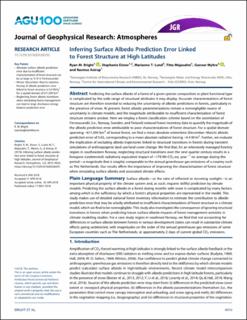| dc.contributor.author | Bright, Ryan M. | |
| dc.contributor.author | Eisner, Stephanie | |
| dc.contributor.author | Lund, Marianne Tronstad | |
| dc.contributor.author | Majasalmi, Titta | |
| dc.contributor.author | Myhre, Gunnar | |
| dc.contributor.author | Astrup, Rasmus Andreas | |
| dc.date.accessioned | 2021-05-06T13:34:23Z | |
| dc.date.available | 2021-05-06T13:34:23Z | |
| dc.date.created | 2018-06-22T09:15:00Z | |
| dc.date.issued | 2018 | |
| dc.identifier.citation | Journal of Geophysical Research - Atmospheres. 2018, 123 (10), 4910-4925. | |
| dc.identifier.issn | 2169-897X | |
| dc.identifier.uri | https://hdl.handle.net/11250/2754000 | |
| dc.description.abstract | Predicting the surface albedo of a forest of a given species composition or plant functional type is complicated by the wide range of structural attributes it may display. Accurate characterizations of forest structure are therefore essential to reducing the uncertainty of albedo predictions in forests, particularly in the presence of snow. At present, forest albedo parameterizations remain a nonnegligible source of uncertainty in climate models, and the magnitude attributable to insufficient characterization of forest structure remains unclear. Here we employ a forest classification scheme based on the assimilation of Fennoscandic (i.e., Norway, Sweden, and Finland) national forest inventory data to quantify the magnitude of the albedo prediction error attributable to poor characterizations of forest structure. For a spatial domain spanning ~611,000 km2 of boreal forest, we find a mean absolute wintertime (December–March) albedo prediction error of 0.02, corresponding to a mean absolute radiative forcing ~0.4 W/m2. Further, we evaluate the implication of excluding albedo trajectories linked to structural transitions in forests during transient simulations of anthropogenic land use/land cover change. We find that, for an intensively managed forestry region in southeastern Norway, neglecting structural transitions over the next quarter century results in a foregone (undetected) radiatively equivalent impact of ~178 Mt‐CO2‐eq. year−1 on average during this period—a magnitude that is roughly comparable to the annual greenhouse gas emissions of a country such as The Netherlands. Our results affirm the importance of improving the characterization of forest structure when simulating surface albedo and associated climate effects. | |
| dc.language.iso | eng | |
| dc.title | Inferring Surface Albedo Prediction Error Linked to Forest Structure at High Latitudes | |
| dc.type | Peer reviewed | |
| dc.type | Journal article | |
| dc.description.version | publishedVersion | |
| dc.source.pagenumber | 4910-4925 | |
| dc.source.volume | 123 | |
| dc.source.journal | Journal of Geophysical Research - Atmospheres | |
| dc.source.issue | 10 | |
| dc.identifier.doi | 10.1029/2018JD028293 | |
| dc.identifier.cristin | 1593072 | |
| dc.relation.project | Norges forskningsråd: 243803 | |
| dc.relation.project | Norges forskningsråd: 250113 | |
| dc.relation.project | Norges forskningsråd: 244074 | |
| dc.relation.project | Norges forskningsråd: 254966 | |
| cristin.unitcode | 7475,0,0,0 | |
| cristin.unitname | CICERO Senter for klimaforskning | |
| cristin.ispublished | true | |
| cristin.fulltext | original | |
| cristin.qualitycode | 2 | |
